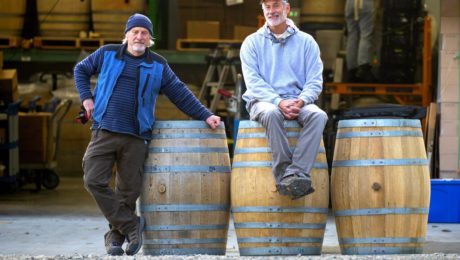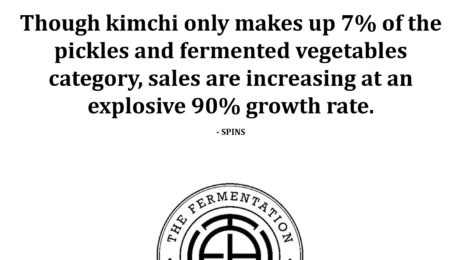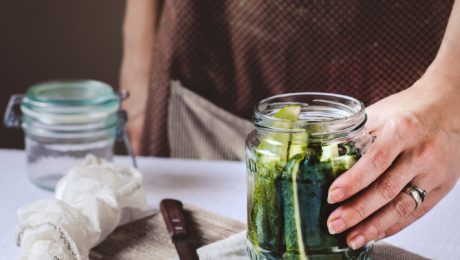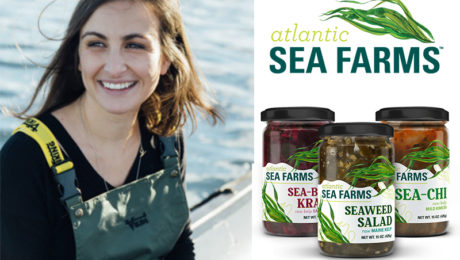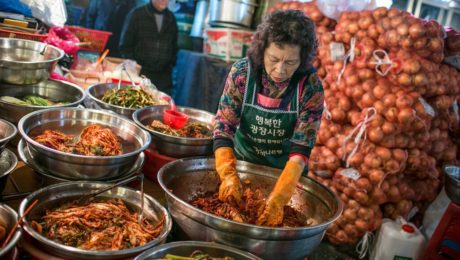Keeping Traditional Fermentation Alive
Britt’s Fermented Foods is one of the only pickle companies in America still using oak barrel fermentation — how pickles were first fermented in ancient Egypt. But this method is often difficult and time-consuming, and many producers abandoned it in the 1970s when food regulation laws changed.
“The oak barrel has that ability to act as an agent in the fermentation,” says owner Britt Eustis. He explained to The Seattle Times that “the tannins in the oak barrels suppress the enzyme that naturally occurs and makes pickles turn soft,” keeping Britt’s pickles crisp.
Britt’s, with a warehouse on Whidbey Island in Washington, nearly shut down in 2019 due to mounting debt and production challenges. But a blueberry farm on the island offered to partner with the company, offering financial backing and helping to diversify income streams. Britt’s now sells kimchi and sauerkraut, also fermented in oak.
Read more (Seattle Times)
- Published in Business, Food & Flavor
Kimchi Sales Exploding in Growth
Though kimchi only makes up 7% of the pickles and fermented vegetables category, sales are increasing at an explosive 90% growth rate. – SPINS
- Published in Business, Food & Flavor
Global Fermentation: Today & Tomorrow
The health attributes and unique flavors of fermented food and drink are becoming increasingly more important to consumers. But, for fermentation brands to succeed in the food industry, they must prioritize their labeling and marketing, and focus on their environmental impact, says international food industry expert Lisa Moeller.
“Hopefully, it will be as advantageous to attach ‘Fermented’ as it is ‘Fresh Pack’ to shelf stable pickle products at some point in time,” says Moeller, speaking at a recent TFA webinar: Global Fermentation: Today & Tomorrow. “Never in our history has the power of positive change been more possible and necessary. I think there is an inherent history with fermented vegetables and a trajectory that can only take them higher going forward.”
After receiving her master’s degree in food science, Moeller spent 25 years working with Mount Olive Pickle Company in North Carolina. She later started her own company, Fashionably Pickled, where she consults to food brands on methods – such as assisting with traditional fermentation technology – for crafting better products.
Fred Breidt, microbiologist with USDA-ARS and a TFA advisory board member, called Moeller “one of the premiere pickle people in the United States,” and praised her for working around the world on a variety of fermentations.
Moeller shared three forecasts for fermented foods.
- Health Concerns Become More Important
Consumers are more concerned about their health during the COVID-19 pandemic. “Folks are looking to boost immunity, reduce their weight and they’re looking for nutritious options,” Moeller says.
People are also cooking more at home during the pandemic. Restaurant dining had continually increased over the previous two decades and, in recent years, only half the food eaten in the U.S. was purchased from a grocery store. But when COVID-19 hit, “this 23 year trend was blown out of the water,” says Moeller. By April 2020, 65% of the food consumed came from a grocery store, with less than 35% from restaurants.
“I think this trend gives the fermented vegetable arena great potential,” Moeller says. “Fermented vegetables can increase the shelf life of produce, they’re nutritious, and they can be turned into a wide variety of flavors. And I think for a time, people are going to be more interested in having a supply of things in their pantry when they don’t feel comfortable going to a grocery store.”
Increased research will help promote fermentation as a viable health food. There are still consumers who are off-put by fermentation, leaving room for brands to educate.
“Though a large part of the pickle industry is still involved with fermented cucumbers, it is not the leader in the retail category at this time,” Moeller says. “We don’t label ‘fermented’ in America. Lots of times with the cucumber industry, the fermented kind of becomes the offshoot. It’s kind of the have-to-do so you can produce all the fresh pack that you want and still have a home for others.”
- Labelling and Marketing Are Crucial
Food product labels and marketing must adapt to their local markets. Brands must create different labelling, packaging and marketing plans, depending on the country.
“There truly is no such thing as global tastebuds. But there are successful product adaptations,” Moeller says.
Consider Kentucky Fried Chicken (KFC) as an example. There are over 23,000 KFC locations in 140 countries, and the restaurants adapt to regional flavor preferences, selling different styles of food depending on the location. Coca-Cola is another example. With 500 brands in 200 countries, a can of Coke will taste different depending on the country where it was sold.
“Labelling is even more important when selling your brand. Know what is important to the folks that are going to make the decision to add you products to their store shelves. Whole Foods is different than Walmart,” Moeller adds.
She advises to never make a label too complicated. Yogurt sales are projected to drop by 10% by 2024 “and this is partially because there are too many choices and the category has gotten too complicated.”
- Environmental Concerns Lead to Upcycllng
The environment is a big topic of concern worldwide, Moeller says.The global food system accounts for 26% of greenhouse gas emissions, 40% of the food produced is never consumed and 78% of global consumers are concerned about the environment.
Upcycling will be the new food trend. Brands like Toast Ale (beer made from old bread) and RISE + WIN Brewing Co. (who recycle grain scraps to make granola and sweets) are already making waves in the industry. During the pandemic, chefs reported using fermentation more than ever before to make use of uneaten produce.
“There’s not a vegetable out there that could be turned into something else,” Moeller says. “Turning food waste into alternative products…I think it’s one of the most wonderful ideas, (brands) need to partner with the folks that they want to get these byproducts from.”
- Published in Business, Food & Flavor
Chefs Predict More Fermentation
Fermentation is on the list of chef’s biggest food trends for 2021. Though fermentation has been climbing “Best of” chef lists for years, most chefs use fermentation to increase the flavor profile of a dish. In 2020, though, as restaurants dealt with various stages of closures and lost business, more chefs used fermentation in its traditional use: preservation. Fermentation became a way to preserve the unused ingredients they had on-hand, and continue buying produce from farmers.
“Fermentation is becoming really big again…I think a lot of us fell in love again with this type of way of preparing food,” says Jorge Guzmán @jorgeguzman1 chef/owner at Minneapolis-based Petite León and a James Beard Award nominee.
Read more (Food and Wine)
- Published in Food & Flavor
Q&A with CEO of Atlantic Sea Farms
Atlantic Sea Farms began 2020 with landmark accomplishments. Their food service partnerships were bigger than ever, providing ready-cut kelp for David Chang’s kelp bowl created for Sweetgreen restaurants, seaweed kimchi for B.GOOD restaurant’s burgers and a kelp puree for salad dressing at Western Pennsylvania restaurant Lil’ Bit.
Then the coronavirus pandemic business shuttered restaurants, and Atlantic Sea Farms — which had sold 90% of their Maine kelp to food service establishments — had to flip their business model. Their new fermented products (Fermented Seaweed Salad, SeaChi, SeaKraut) and frozen Ready-Cut Kelp and Kelp Cubes became the focus of kelp processing. Atlantic Sea Farms will end 2020 processing 900,000 pounds of kelp and selling their retail product in 800 stores.
“People are excited about what we’re doing. We’re fermenting seaweed, and it tastes really damn good. We have retail buyers even at a time when every store is limiting SKUs, and they want our product,” says Brianna Warner, CEO of Atlantic Sea Farms. “The seaweed people typically eat in the United States is imported dry, rehydrated, then dyed with all the same chemicals that’s in Mountain Dew. But we are making a fermented seaweed that’s fresh, healthy and has all the goodness that comes from fermentation and kelp.”
Atlantic Sea Farms launched nine years ago as the first seaweed farm in the country. The majority (98%) of seaweed Americans eat is imported from Asia dried and unnaturally dyed. American-grown seaweed is still a new concept. When Warner became CEO two years ago, she set big goals for the small company. She wants Atlantic Sea Farms to provide alternative income sources for Maine’s lobster farmers, clean the water to aid climate change and make healthy food. They’ve increased the amount of kelp they produce to 14 times what they did two years ago and, by 2021, they will be in retail locations all over the U.S.
Coming on the heels of numerous awards for their one-of-a-kind, fermented kelp-based products, Warner spoke with TFA about Atlantic Sea Farms.
TFA: Tell me how your work at the Island Institute (Maine’s community sustainability non-profit) introduced you to Atlantic Sea Farms.
Briana Warner: At the time, Atlantic Sea Farms was called Ocean Approved and they were basically just a farming company. They were growing seeds and farming and I’m a development economist by trade. I was in the foreign service for a number of years before I moved to Maine. And the big question that the Island Institute was trying to solve and why they hired me as their first economic development director is we’re so dependent on this natural resource, which is lobster. It’s a lobster monoculture, we’re one of the most rural states in the country, we’re the oldest state in the country as far as demographics go, and there’s very little else in many of these communities other than lobster. There just is no diversity.
At the same time in Maine, we’ve had 10 of the best lobster farming years in the past 20 years. But that is worrying. Why? We know the Gulf of Maine is warming faster than 99% of oceans worldwide, and we know that’s because there’s arctic ice melt that’s creating a confluence of currents that gives the best opportunity for lobsters to thrive here. But what that ultimately means is it will continue to warm. And it will continue to warm to the point that lobsters are no longer surviving at the rate than they’re surviving now.
So with my economic development background, the ultimate solution is to provide alternative supplemental sources of income now while people have the money to invest in it. This is a way to absorb some of the shock of that lobster volatility so that in 10, 15, 20, 30, 40 years, whenever it is that lobster isn’t as secure as it is now. And it’s not secure now either — we know there will be lobsters now, we just don’t know where the price is, we don’t know where it will go, that’s some of the volatility, and all the eggs are in that basket.
The ultimate proof of concept is if we’re able to help people adapt to this kind of economic change and at the same time, mitigate some of its climate change effects. Because when you plant seaweed, you’re actually removing carbon and nitrogen from the water and reducing acidification locally. So it’s this incredible crop that’s off season to the lobster income.
I started working with fishermen to start getting them into seaweed, but the problem is there is no institutional buyers at scale in the entire country. We were the first commercial seaweed farm in the country, when I joined, they were just farming their own seaweed but not buying anything from anyone else. So we really had to think big about what could the supply chain look like? And how could we make this a viable alternative income for fishermen?
The answer to that is, first, make a good product that people want. Second, make sure that that money goes back to the fishermen. And that’s really what our entire business model is based around. Coming up with products that are really delicious, putting them out there in a way that’s accessible, because right now 98% of the seaweed that we eat in the United States is imported, Fresh seaweed is not something anyone has had in the United States. This is a totally different product from the very very cheap stuff that comes from Asia, and it’s a very clean product because it’s grown in the clean, cold waters of Maine by independent fishermen farmers. And it tastes good. Our supply chain that we’ve built from that narrative, we create all the seeds in house, we give them out to our farmers for free, then we guarantee purchase of every single blade of kep that they grow.
When someone is buying a jar of our Fermented Seaweed Salad, that money is going back quite literally into the pockets of fishermen because our whole supply chain is built around as much as we can sell, the more we can put in the water and buy. Then we can make the ocean cleaner, we can make the coast healthier from an economic perspective, and the products are really good for the consumer and taste good. So it’s sort of this five-legged stool that we’re constantly working towards.
TFA: How does kelp farming work?
BW: Our fishermen usually have four-acre farms, so you lease the water. You have to get a permit and a lease (from the state), which takes many months if not years. And we help them with all of that. We provide all the technical assistance for their site selection and leasing requirements. And then on four acres, they put two mooring balls at either end of about 1,000 foot of line, and they do this 13 times on the farm. They put it about 7-feet under water, so all you can see is mooring balls. They put it on these 1,000-foot, horizontal ropes and the kelp starts growing. Kelp grows up to 6-inches a day in the warmer summer months. So it really grows very quickly. We harvest what we call a baby kep because it’s so young. Because it’s at the top of the water column, its this incredibly high-quality food that allows us to serve it fresh in a way that wild harvest wouldn’t because wild harvest you don’t know if you’re getting a 4-year-old plant or an 8-year-old plant whereas, with us, we’re harvesting very young, very tender, very clean kelp that’s at top of the water column.
Right now, we work with 24 kelp farmers. It’s owner-operator run, they have the license to fish and own their own boat. Our farmers work lobster season from June to November, plant our kelp seeds in November and December, then start harvesting them in April. Kelp is the inverse of lobster season.
TFA: Atlantic Sea Farms was just a kelp farm when you joined the company two years ago. Why expand to commercial products?
BW: We were growing 30,000 pounds of kelp a year when I came on in 2018, and now our kelp farmers are growing 900,000 pounds of kelp a year. We rebranded and came out with all these products in 2019 because 30,000 pounds is such a small scale. Nobody is going to make money from doing that, especially farmers. If we really want to make an impact on the coast, there’s a sense of urgency to build this quickly and make sure that we get the scale that we need so we can actually help absorb some of that shock.
Most lobster in America is actually sold to restaurants. But with COVID, people had absolutely no idea what kind of season they were going into this year. It was terrifying. But we were able to send out an email before kelp harvest season saying “There’s a whole lot to worry about right now, but us picking up is not one of those things. We will be there and we will honor every commitment we have.” And it was not easy. It was very, very challenging. And we did it. Because we know above all else, integrity along this coast is what we’re built on and what we’re doing this for. So if we can’t do that, what are we doing? So we picked up, by the last dollar we had.
We were mostly working in food service, that’s why there was such a big fallout. But we had these fermented products that were used in some food service locations but were mostly part of our regional brand we were building in New England. We have our jars, we have our frozen products. They were just in the region. And we really just turned it on its head and went after buyers of national chains for retail and switched our food service to retail. We’ll be launching in Sprouts in January with our frozen products, we’re in several regions of Whole Foods already and we’ll be in more starting in April, we’re in MOMS, Wegmans, all these places where there are ferments. We feel very blessed and very lucky, we’ve been working our tails off. I can’t quite say it’s worked yet. We’ve got these placements, now we’ve got to slam these out. In June we were in 100 stores but by January, we’ll be in 800 stores.
TFA: What does Maine kelp taste like?
BW: It’s very fresh, very vegetal, very light. For our ready cut, for our cubes and for our fermented salad, We blanche it so it knocks off the sort of low-tide taste. That also gives it the green color because, when you dip seaweed in hot water, it turns bright green, so we don’t ever use any dyes or anything. For our SeaChi and our Sea-Beet Kraut, we use it raw because people want those kick-in-your face flavors. If you like kimchi, you’re not going to be afraid of a pretty hard umami taste. It makes our SeaChi so good to have that deep, ocean flavor on it that you’d usually have to use fish sauce for. The blanched seaweed really tastes super mild. It kind of takes on the flavor of whatever you put in it. It’s loaded with calcium, potassium and iodine.
TFA: Have you seen Americans’ perceptions of eating seaweed change? Do you think their perceptions of fermented food have changed, too?
BW: Absolutely. With seaweed, two of the top importers of seaweed are Trader Joes and Costco. People are eating it. There’s nori sheets everywhere and there’s sushi restaurants in the farthest reaches of America. It’s everywhere. People have definitely gotten a taste for seaweed. It’s new for Americans to have it in a form that’s not dried. People want to know where their food comes from, they want to know the food they are eating is regenerative, which is what kelp is, it’s taking carbon and nitrogen out of the water. We don’t use any arable land, we have no fertilizer, we have no fresh water, it’s like this climate change diet dream, everything in it is better for the environment. People also want to know the people connected to it — all our products have the faces of our farmers on it — it checks all those boxes. Let alone it tastes good and it’s good for you.
That’s similar with fermentation. Years ago, fermentation might have been ripe to have it on the menu, but quite frankly, everything out there wasn’t that good. It was these plastic bags of sauerkraut that tasted like pork and sauerkraut. There wasn’t anything else out there. Then you saw some kimchi coming out in the market that you didn’t really know what it said because there wasn’t a whole lot of English writing on it. Then the branding started coming and it started being in more food. For fermentation, it’s been a slow but obvious move because it’s good for you and, again, it tastes good. We just have to take the intimidation factor out, and I think fermentation did that already, and now we’re trying to do that with seaweed.
TFA: Why ferment seaweed?
BW: Part of it is that’s the best way to store it. But the other part of it, the Venn diagram between people who eat kimchi and people who are excited about beet kraut and fermented foods and those who aren’t intimidated at all by seaweed is pretty overlapping. There are few people who say “I like fermented food — but seaweed, ew.” The low hanging fruit is so substantial. That’s kind of our first folks we can approach, they can be our true believers and then they help us advocate for what we’re doing.
TFA: How much time did it take to perfect these recipes?
BW: I’d been playing with them for years. SeaChi was something I was doing — buying kimchi and putting our kelp in it. And the Sea-Beet Kraut came from the fact that beets and kelp really go well together, they’re both very sweet and ferment well together. We spent months trying to figure out how to not make that sugar turn it into a mess of purple explosion.
But we started working with this wonderful company called Chi Kitchen Foods based out of Rhode Island, and they make kimchi and vegan kimchi. So we basically took the recipes as far as we could take it, then we brought it to Minnie (Minnie Luong, founder Chi Kitchen Foods) and basically begged her to help us figure it out. Our speciality is in kelp. We do all the kelp, and then they make the kimchi. They basically helped us commercialize our fermented products.
TFA: Tell me about being a female CEO. Females often make the purchasing decisions for the home. What perspective do you bring to the table?
BW: On top of female CEO, female CEO in seafood. That’s been rarer. Seafood is a white male-dominated category. Most of the fishermen we work with are men — we have one woman.
We have an absolutely broken food system. Things don’t work. People aren’t making more money who are producing the food. The good food is not getting cheaper, and the bad food is getting cheaper. Food is one of the biggest polluters to our planet. Our priorities in what we eat and how to get the food to our table are completely off center and completely broken and creating a massive devastation both on our health and on the health of the environment.
This is not to slight my male counterparts, but that thinking happened under the leadership of men. So instead of taking the same thinking and trying to slightly adjust it, let’s absolutely rethink how we look at our food system. That’s going to take different minds, and it’s going to take different approaches. And I think women are in the best position to do that. We want to feed our children and we want to feed our planet. We look beyond five years in the future. Our plan is our grandchildren and the health of our families and the health of us. While that may be a vast generalization, I think we really need to look at who broke the system and how we can fix it. And that’s going to take all types of thinking.
TFA: Where do you see the future of fermented products?
BW: The future of fermented foods is wide open. We’ve seen, there’s been such a shift in the past year or two in branding, flavor. It used to be sort of this niche thing of a few sauerkrauts and kimchis that all varied in taste only slightly. Then everyone started doing a bunch of cool stuff with those products in their home kitchens or in restaurants. But you couldn’t find those cool things on the shelf. I think we’re starting to see people looking beyond cabbage and recognize that fermentation can happen in so many forms. Just like the homebrewers spurred craft brewers. People are realizing there’s a lot of innovation to be had and buyers are realizing the fermented category isn’t limited to just health food people anymore. It’s people who really want to get those probiotics but also the flavor of the fermentation in the first place. Kombucha has shown us that, obviously. There’s a lot of different forms of fermented stuff out there right now that people are going to simply because it says the word fermented. The possibilities, I think we’re just at the beginning.
- Published in Business, Food & Flavor
The Clash Over Kimchi
A Chinese tabloid has set off a social media war between China and South Korea. Global Times claimed China led the development of an international standard for paocai (pickled vegetables). Koreans said the claim was misleading because, in Chinese, paocai refers to kimchi, too. And kimchi is a fermented cabbage dish that is central to Korean cuisine.
Koreans are accusing the Chinese of cultural appropriation. “If China plagiarizes the fermentation process of kimchi in the future, then South Korea’s traditional culture may disappear.”
Read more (New York Times)
- Published in Food & Flavor
Food and Beverage Laws Passed in 2020
Every year, the nation’s 50 state legislatures pass dozens of new laws that have an impact on fermenters. For example, some states amended alcohol laws to allow drink sampling for craft wineries, while others repealed outdated cottage food laws to help small producers operate and more loosened take-out restrictions to help small restaurants survive the pandemic.
Indicative of this year’s focus on the pandemic, laws were introduced but never debated as lawmakers focused on more pressing issues surrounding the coronavirus. The most common new laws passed in 2020 revolved around helping businesses survive — states called special sessions to aid restaurants, stop price gouging of high-demand products and provide emergency grants to small businesses.
Read on for key food, beverage and food service laws passed this year, most taking effect in 2021.
California
AB82 — Prohibits an establishment with an alcohol license from employing an alcohol server without a valid alcohol server certification.
AB3139 — Establishments with alcoholic beverages licenses who had premises destroyed by fire or “any act of God or other force beyond the control of the licensee” can still carry on business at a location within 1,000 feet of the destroyed premise for up to 180 days.
Delaware
HB 237 — Eliminates old requirements that movie theaters selling alcohol must have video cameras in each theater, and that an employee must pass through each theater during a movie showing.
HB275 — Permits beer gardens to allow leashed dogs on licensed outdoor patios.
HB349 — Permits any restaurant, brewpub, tavern or taproom with a valid on-premise license to sell alcoholic beverages for take-out or drive through food service, so long as the cost for the alcohol did not exceed 40% of the establishment’s total sales transactions.
Hawaii
SR84 — Creates a Restaurant Reopening Task Force to help restaurants in Hawaii safely reopen that were closed during the COVID-19 pandemic.
SR94 — Urges restaurants to adopt recommended best practices and safety guidelines developed by the United States Food and Drug Administration and National Restaurant Association in response to the COVID-19 pandemic.
Idaho
HB343 — Amends existing law to require licensing to store and handle wine as a wine warehouse.
HB575 — Allows sampling of alcohol products at liquor stores, which was formerly forbidden under law.
SB1223 — Eliminates obsolete restrictions on food products, to match federal standards. It repeals requiring extra labels on some imported food products, and repeals using enriched flour in bread baking.
Illinois
HB2682 — Amends Liquor Control Act of 1934. Allows a cocktail or mixed drink placed in a sealed container at the retail location to be sold for off-premises consumption if specified requirements are met. Prohibits third-party delivery services from delivering cocktails or mixed drinks.
HB4623 — Amends Food Handling Regulation Enforcement Act, regulating that public health departments provide a certificate for cottage food operations, which must be displayed at all events where the licensee’s food is being sold.
Iowa
HB2238 — Amends code regarding food stands operated by a minor. Bans a municipality from enforcing a license permit or fee for a minor under the age of 18 to sell or distribute food at a food stand.
Kentucky
HB420 — Implements Food Safety Modernization Act, authorizing a department representative to enter a covered farm or farm eligible for inspection.
SB99 — Amends alcohol laws for state’s distillers, brewers and small wineries. Eliminates the sunset on local precinct elections to grant distilleries, and allows distillers to sell other distiller’s products.
Louisiana
HR17 — Allows third-party delivery services to deliver alcohol.
HB136 — Makes adulterating a food product by intentional contamination a crime.
SB455 — Increases the size of containers of high-alcoholic beverages.
SB508 — Gives restaurants protection from lawsuits involving COVID-19. The public will be unable to sue restaurants for COVID-19-related deaths or injuries, as long as the restaurant complies with state, federal and local regulations about the virus.
Maine
LD1167 — Encourages state institutions to serve Maine food and Maine food products, increasing the visibility of the state’s local food producers.
LD1884 — Amends current laws regarding businesses that hold dual liquor licenses, which authorized retailers to sell wine for consumption both on- and off-premise. Retailers with the dual license can now sell with just one employee at least 21 years of age present, and adds that wine can be sold for take-out if food is part of the transaction.
Maryland
HB1017 — Allows cottage food businesses to put their phone number and business ID on their food label, rather than their address as currently required by the Maryland Department of Health.
SB118 — Expands definition of “alcohol production” and “agricultural alcohol production.” The new definitions aim to give Maryland farmers and producers the ability to sell beer, wine and spirits to increase agritourism.
Massachusetts
SB2812 — Expands alcohol take-out and delivery options during COVID-19 pandemic. Allows restaurants to sell mixed drinks in sealed containers alongside other take-out and delivery food orders.
Michigan
HB5343 — Revises regulations on brewpubs and microbreweries, increasing the quantity of beer a microbrewer is permitted to deliver to a retailer during a year from 1,000 barrels to 2,000 barrels.
HB5345 — Amends the Michigan Liquor Control Code to delete the Michigan Liquor Control Commission (MLCC) $6.30 tax levied on each barrel of beer manufactured and sold in Michigan.
HB5354 — Amends the Michigan Liquor Control Code to delete the requirement that a brewpub cannot sell beer in Michigan unless it provides for each brand or type of beer sold a label that truthfully describes the content of each container.
SB711 — Establishes new limited production brewer license for microbreweries at cost of $1,000 for license.
HB5356 — Amends the Michigan Liquor Control Code to ban the required $13.50 cent-per-liter tax on all wine containing 16% or less of alcohol by volume sold in Michigan.
Minnesota
HB5 — Authorizes emergency, small-business grants and loan funding for businesses affected by COVID-19.
HB4599 — Extends period of mediation for Minnesota farmers suffering economic difficulties to keep their farm.
Mississippi
HB326 — Amends outdated code to increase the maximum annual gross sales for a cottage food operation (from $20,000 to $35,000) before the producer would need to pay food establishment permit fees. Authorizes a cottage food operation to advertise products over the internet.
New Jersey
AB2371 — Requires large generators of food waste (like restaurants and supermarkets) to recycle food garbage rather than send it to incinerators or landfills.
AB3865 — Limits return of food from retail food stores during a public emergency.
SB864 — Prohibits sale of single-use plastic carryout bags, single-use paper carryout bags and polystyrene foam food service products, and limits single-use plastic straws.
SB1591 — Allows alcoholic beverages to be consumed from open containers in the Atlantic City Tourism District.
SB2437 — Limits service fees charged to restaurants by third-party food takeout and delivery applications during COVID-19 pandemic.
New Mexico
SB3 — Enacts the Small Business Recovery Act of 2020, which provides loans for small businesses suffering during the coronavirus pandemic.
New York
SB8225 — Authorizes issuing a retail license for on-premise consumption of food and beverage within 200 feet of a church, synagogue or other place of worship.
AB8956 — Allows a licensed brewery or farm brewery to provide no more than four beer samples not exceeding four fluid ounces each.
SB1472 — Requires hospitals to offer plant-based food options to patients upon request.
SB7013 — Authorizes the manufacture and sale of ice cream or other frozen desserts made with liquor.
North Carolina
SB290 — The Alcoholic Beverage Control Regulatory Reform Bills, it allows distilleries the same serving privileges as wineries and craft breweries and reduces regulation on out-of-state sales.
Ohio
HB160 — Aid for the restaurant industry to recover from COVID-19 pandemic, the bill doubles the maximum number of Designated Outdoor Refreshment Areas (DORAs) that can be created in a municipality or township. Also allows Ohio’s small wineries to sell prepackaged food without regulation from the Ohio Department of Agriculture, creates bottle limits for micro-distilleries and permits license holders to sell alcoholic ice cream.
South Carolina
HB4963 — Amends state alcohol code, allows licensed retailers to give wine samples in excess of 16% alcohol, cordials or distilled spirits, as long as they don’t exceed a total of three liters a year.
SB993 — Amends state alcohol code to allow a permitted winery to be eligible for a special permit to sell wine at off-premise events. Also increases the amount of beer a brewery can sell to an individual per day for off-premise consumption.
South Dakota
HB1073 — Authorize special event alcohol licenses for full-service restaurant licensees.
HB1081 — Allows colleges to teach brewing beer and wine classes on South Dakota campuses to students age 21 or older. Brewing must be held off campus as the education institution is not deemed a licensed manufacturer. Any distilled spirits, malt beverage, or wine produced under this section may only be consumed for classroom instruction or research and may not be donated or sold.
Tennessee
SB2423 — Allows alcohol sales at the Memphis Zoo.
SB1123 — Encourages farmers who produce raw milk to complete a safe milk-handling course.
Utah
HB134 — Legalizes the sale of raw butter and raw cream in Utah;
HB232 — An agri-tourism bill that allows farms and ranches to host events that include food that would not need to be prepared in a commercial kitchen. Farmers must apply for a food establishment permit to use their private home kitchen.
HB399 — Changes to the Alcohol Beverage Control Act, prohibits advertising that promotes the intoxicating effects of alcohol or emphasizes the high alcohol content of an alcoholic product.
HB5010 — The COVID-19 Cultural Assistance Grant Program, which appropriates $62 million for struggling arts, cultural and recreational organizations and businesses across the state.
HB6006 — In response to the coronavirus pandemic, the bill amends the Alcohol Beverage Control Act, delaying the expiration date of the retail licenses set to expire in 2020 for places selling alcohol. Also permits alcoholic beverage licensees at international airports to change locations if needed.
Vermont
SB351 — A coronavirus relief bill which authorizes $36 million for agriculture and forestry sectors.
Washington
HB2217 — An update to Cottage Food Law eliminates the requirement that a home address must be put on a food label.
HB2412 — Increases amount of additional retail licenses for a domestic brewery or microbrewery from two to four, and directs health department to adopt rules allowing brewery owners to allow dogs on brewery premise
SB5006 — Allows sale of wine by microbrewery license holders.
SB5323 — A bill eliminating single-use, plastic carry-out bags
SB5549 — Modernizing resident distillery marketing and sales restrictions. Allows distilleries to sell products off-premise, similar to breweries and wineries.
SB6091 — Continues work on the Washington Food Policy Forum, including support for small farms and increasing the availability of food grown in the state.
West Virginia
HB4388 — Removes outdated restrictions on alcohol advertising, limiting the Alcohol Beverage Control Commissioner’s authority to restrict advertising in certain advertising mediums, such as at sporting events and highway billboards.
HB4524 — Making the entire state “wet,” permitting the off-premises sale of alcoholic liquors in every county and municipality in the state.
HB4560 — Permits licensed wine specialty shops to sell wine with a gift basket by telephonic, electronic, mobile or web-based wine ordering. Establishes requirements for lawful delivery.
HB 4697 — Removes restriction that a mini-distillery use raw agricultural products originating on the same premises
HB4882 — Allows unlicensed wineries not currently licensed or located in West Virginia to provide limited sampling and temporary, limited sales for off-premise consumption at fairs, festivals and one-day nonprofit events “in hopes that such wineries would eventually obtain a permanent winery or farm winery license in West Virginia.”
Wisconsin
HB1038 — Bans customers from returning food items during a health pandemic or emergency, dissuading people from stocking up on too many supplies.
SB83 — Increases sales volume of alcohol by retail stores from four liters per transaction to any quantity.
SB170 — Allows minors to operate temporary food stands without a permit or license.
Wyoming
HB82 — Authorizes a microbrewery to operate at more than one location. The local licensing authority may require the payment of an additional permit fee not to exceed $100.00.
HB84 — Authorizes the sale of certain homemade food items that do not require time or temperature control. These include but are not limited to:
but is not limited to, jams, uncut fruits and vegetables, pickled vegetables, hard candies, fudge, nut mixes, granola, dry soup mixes excluding meat based soup mixes, coffee beans, popcorn and baked goods that do not include dairy or meat frosting or filling or other potentially hazardous frosting or filling;
“non-potentially hazardous” (no dairy, quiches, pizzas, frozen doughs, foods that require refrigeration and cooked meat, cooked vegetables and cooked beans). Allows someone other than the producer to sell the food, as long as food is not sold in a retail location or grocery store where similar food items are displayed or sold. Food must be labeled with “food was made in a home kitchen, is not regulated or inspected and may contain allergens.”
HB158 — Allows microbreweries to make malt beverages at multiple locations rather than one as deemed in current law.
Retail Sales Trends for Fermented Food and Beverage
Kimchi, fermented sauces and tempeh are driving growth in the fermented food and beverage category, a $9.2 billion industry that’s grown 4% in the last year.
“We’re excited about the growth potential for fermented food. While fermented food represents about 1.4% of the market today, there are segments that are tracking well above the growth of food and beverage [overall] that are poised for disruption in the future,” says Perteet Spencer, vice president of strategic solutions at SPINS. Spencer shared this information in a recent webinar hosted by The Fermentation Association. “There’s a ton of opportunity to scale and increase the footprint of these products.”
SPINS spent weeks working with TFA to define the fermentation industry’s sales, drilling into 10 fermented product categories and 57 product types. Wine, beer and cheese sales were excluded from the data — those categories are very large, and would obscure trends in smaller categories. (All three are also well-represented by other organizations.)
Pickles and fermented vegetables “is a space that’s seen [a] pretty explosive uptick in growth over the past year,” Spencer says. Every segment is growing — kimchi, sauerkraut, beets, carrots, green beans, sliced and speared pickles and all other vegetables — with pickles the largest, nearly 60% of the category.
The biggest growth, though, is coming from products other than pickled cucumbers. Kimchi is at the center of numerous consumer retail trends. Consumers are purchasing healthier food made with fewer ingredients, and they want food with international flavors. Kimchi makes up only 7% of the category, but sales are increasing at an explosive 90% growth rate.
More people are experimenting with fermenting while they’re at home during the coronavirus pandemic, but these kitchen DIYers do not appear to be detracting from sales.
“The more people make fermented foods, they appreciate what’s available in the store that maybe didn’t exist five or 10 years ago,” notes Alex Lewin, author and TFA advisory board member who moderated the webinar. “Anyone who has made kimchi knows it takes a lot, it makes a big mess, you get red pepper powder stuck under your fingernails and onion in your eyes. I can make kimchi (at home), and then once I’ve made kimchi, I’m like ‘Ok, maybe next time I’ll buy it.’”
Fermented sauces are also growing, up 24% in 2020. The largest segment in sauces is, of course, soy sauce, almost 85% of the category. But gochujang, less than 2% of the category, is increasing at over a 56% growth rate.
Versatility is helping sauces, pickles and fermented vegetables, Spencer says. Any food product with multiple uses is selling well. The condiments and sauces can be used as a topping on eggs, hamburgers or pizza, or mixed-in a salad, rice dish or soup.
Sake, plant-based meat alternatives and miso had combined annual growth of $75 million in 2020. Sake grew 16%, and both plant-based meat alternatives and miso each grew 26%.
Yogurt and kombucha still dominate the fermented food and beverage market. Yogurt is 81% of the market; if yogurt is removed, kombucha is 51% of the remainder.. Both have experienced slowdowns in sales from their peaks. Kombucha sales have slowed recently, as grab-n-go opportunities have shrunk during the pandemic.
Yogurt giant brands Chobani, Yoplait and Dannon still dominate the category, as do GT Kombucha, Health-Ade and Kevita reign for kombucha.
Spencer notes the 4% growth rate of fermented products overall would be higher without yogurt. It’s a large category that — despite an uptick in 2020 during the pandemic – has been fairly flat in recent years. Core (traditional) yogurt has been growing at a 1.6% rate; Greek yogurt, at about twice that pace. Those two segments account for roughly 80% of the category.
“This is an opportunity for disruption for emerging brands,” Spencer says. “We’re already seeing some of the legacy segments start to get disrupted by new innovation, so I’m excited to see the evolution of that innovation and where that goes and kind of what opportunities peek out of that.”
“Overall, we’re seeing historically small segments gaining traction in the marketplace,” Spencer adds. “The pandemic has brought a renewed consumer focus on the fermented space.”
Though fermented products have an added healthy benefit, customers are looking for delicious flavor first.
“In these fermented categories we covered today, taste first is always really important. I think people are going to these categories for different taste experiences,” Spencer says. “If you can level up with a functional benefit, that’s fantastic, but we have to balance the taste first. If it’s highly functional but doesn’t taste good, it just doesn’t have the same success.”
- Published in Business
Introduction to HACCP
Creating a HACCP plan — a management system to control food preparation risk — can overwhelm food producers. But Charlie Kalish, food safety consultant and trainer, emphasizes HACCP (Hazard Analysis Critical Control Points) is vital to food safety.
“This is just as important as trying to understand, when I ferment things, why do I ferment? What are the things that get you excited about why you get the flavors that you get or the textures that you get (when you ferment)? The food safety thing, it’s really going to help you in the long run if you approach it with the same excitement because, if you don’t, it’s going to be a lot of work and it will drag you down,” Kalish says during the recent TFA webinar Introduction to HACCP. “I see a lot of people get bitter about (HACCP). ‘It’s such a drain on my resources and what I do!’ But it can help your product get better, it can help you get into new markets. And it is a different language, a different world. Even if you’re not going to get a PhD to understand the basic science underlying the mechanisms, having a strong control of HACCP, food safety, what the expectations are, it’s really going to help you.”
HACCP was originally created for the space program in the ‘60s. NASA needed a high level of assurance that food was going to be safe during missions in space, but traditional food models did not have enough preventive food safety controls. That plan was later adopted by the USDA and FDA to regulate food products.
“HACCP shifted the focus away from recalling food and trying to do damage control with outbreaks to preventing those things from happening in the first place,” Kalish says. “HACCP, in summary, is a systematic approach where we consider all of our ingredients, we consider every process step from when we receive our raw materials or ingredients all the way to the shipping out of our final product, it considers all reasonable and foreseeable hazards.”
Kalish points out HACCP controls for things with a high probability of occuring, like an E. Coli outbreak in lightly fermented food. And a good HACCP plan begins with a solid foundation, basic practices like regular hand washing, sanitizing surfaces and maintaining a comprehensive food safety employee training program.
“Common sense is an excellent guide to get you started for food safety, but I would further suggest to learn as much as you can: the science of the system you’re working with, the microbiology, pH, what it is, how you measure it,” says Fred Breidt, PhD, a microbiologist with the Agriculture Research Division of the USDA. Breidt joined Kalish during the webinar along with moderator Dave Ehreth, president of Sonoma Brinery; both are TFA advisory board members.
Luckily for fermenters, fermentation is a critical control point. In one study on kimchi by Breidt and his USDA colleagues, they found pH level is critical for food safety, a factor controlled by fermentation.
Though the internet can be a wonderful resource to find information on food safety, “you have to be judicious about your sources,” Breidt says. Kalish says to look for guidance from government sources, scientific literature, process authorities, university extension specialists, industry groups and publications or consultants.
Food producers need to budget for HACCP in their financial plan, Kalish advises. Ehreth agrees, and encourages producers still unsure of the process to pay a professional for help “to understand what potential biological hazards could be in that jar of food.”
“The modern food manufacturer is not only a food manufacturer, he is a protector and is entering into a bond of trust with his customers. And that bond of trust says ‘If you buy what I make, you’re not going to die as a result,” Ehreth adds. Though he notes it sounds like extreme advice, it’s a necessity for food producers to keep that creed at the forefront of their production.
- Published in Science
Prospects For Health-Promoting Pickled Vegetables
There are thousands of molecules in the food we eat, but most have yet to be identified. This is especially true in the world of fermentation.
“Lactic acid is not the only byproduct of lactic acid fermentation,” says Suzanne Johanningsmeier, a research food technologist with USDA-ARS. During a TFA webinar, Johanningsmeier presented her research into health-promoting pickled vegetables. “There could be hundreds or thousands of byproducts of this lactic fermentation. As an analytical chemist and someone who is very interested in the composition of foods, I find that fascinating and exciting and a world to explore.”
Johanningsmeier, a leading expert on the chemical and sensory properties of fermented food and veggies, notes that fermentation is a trending food technique. Consumers today want food that is plant-based, enhances gut health, introduces new flavors, made with simple labels and returns to tradition.
“All these things have aligned and intersected for a fermented foods megatrend. It’s exciting to see so much momentum in the Americas rolling for fermented foods,” she says. “All of these trends are based on the belief that these are health promoting foods for consumption.”
The USDA-ARS office in North Carolina State University is staffed by five research scientists, and there are an additional 2,000 more affiliated scientists across the country. Their mission is to deliver scientific solutions to national and global agricultural challenges.
“My long-term goal is to develop science-based technologies that enable the sustainable preservation of fruits and vegetables for production of high-quality, health-promoting consumer products,” Johanningsmeier says.
The most recent USDA-ARS study explored the potential health benefits of fermented cucumbers. Cucumbers are one of the top five vegetables preserved in the U.S. but the only one that’s not canned or frozen. The USDA-ARS found that fermented and pickled cucumbers include many beneficial by-products, including proline, bioactive peptides and GABA (Gamma-Aminobutyric acid, which works as a neurotransmitter in the brain).
“Food processing has a negative connotation. But, actually, fermentation is processing and, as you can see, processing can be good. Processing can add things and certainly make food available to people year round,” Johanningsmeier says. “I think the idea here is how do we preserve [food] so we retain or enhance those inherent, health-promoting properties? The abilities we have now to more comprehensively look at composition are going to help us understand that in the future.”
Maria Marco, professor of food science and technology at University of California, Davis (and TFA Advisory Board member), moderated the discussion. Marco praised Johanningsmeier’s use of analytical techniques to implement fermentation technologies.
“These are exciting compounds, and we know that they have neuroreactive properties or antihypertensive properties,” Marco says.
- Published in Health

